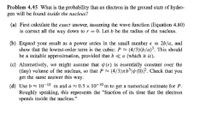Question

Transcribed Image Text:Problem 4.45 What is the probability that an electron in the ground state of hydro-
gen will be found inside the nucleus?
(a) First calculate the exact answer, assuming the wave function (Equation 4.80)
is correct all the way down to r = 0. Let b be the radius of the nucleus.
(b) Expand your result as a power series in the small number € = 2b/a, and
show that the lowest-order term is the cubic: P≈ (4/3)(b/a)³. This should
be a suitable approximation, provided that b <a (which it is).
(c) Alternatively, we might assume that (r) is essentially constant over the
(tiny) volume of the nucleus, so that P≈ (4/3)πb³|y(0)³². Check that you
get the same answer this way.
(d) Use b≈ 10–¹5 m and à ≈ 0.5 × 10-10 m to get a numerical estimate for P.
Roughly speaking, this represents the "fraction of its time that the electron
spends inside the nucleus."
Expert Solution
This question has been solved!
Explore an expertly crafted, step-by-step solution for a thorough understanding of key concepts.
Step by stepSolved in 6 steps

Knowledge Booster
Similar questions
- 6.2 Let the "uniform" ensemble of energy E be defined as the ensemble of all systems of the given type with energy less than E. The equivalence between (6.29) and (6.27) means that we should obtain the same thermodynamic functions from the "uniform" ensemble of energy E as from the microcanonical ensemble of energy E. In particular, the internal energy is E in both ensembles. Explain why this seemingly paradoxical result is true.arrow_forward2.5.2 (a) (b) From the results of Exercise 2.5.1, calculate the partial derivatives of f. 6, and with respect to r, e, and . With V given by 1a rsine ap är (greatest space rate of change), use the results of part (a) to calculate V-Vy. This is an alternate derivation of the Laplacian. Note. The derivatives of the left-hand V operate on the unit vectors of the right-hand V before the unit vectors are dotted together.arrow_forwardcould you also explain to me how you come up with question A?arrow_forward
- Problem 4.25 If electron, radius [4.138] 4πεmc2 What would be the velocity of a point on the "equator" in m /s if it were a classical solid sphere with a given angular momentum of (1/2) h? (The classical electron radius, re, is obtained by assuming that the mass of the electron can be attributed to the energy stored in its electric field with the help of Einstein's formula E = mc2). Does this model make sense? (In fact, the experimentally determined radius of the electron is much smaller than re, making this problem worse).arrow_forward(a) Write down the wave functions for the three regions of the potential energy barrier (Figure 5.25) for E < U₁. You will need six coefficients in all. Use complex exponential notation. (b) Use the boundary conditions at x = 0 and at x = L to find four relationships among the six coeffi- cients. (Do not try to solve these relationships.) (c) Sup- pose particles are incident on the barrier from the left. Which coefficient should be set to zero? Why?arrow_forwardMatharrow_forward
arrow_back_ios
arrow_forward_ios